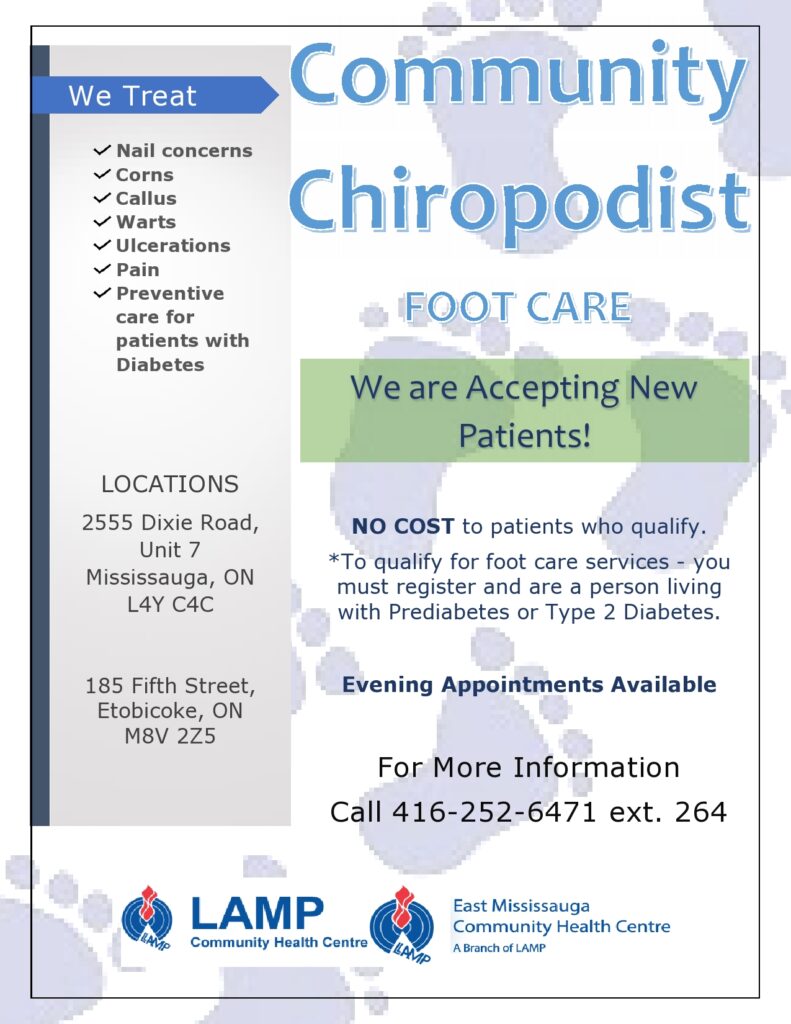May 5, 2021
May is Foot Health Month and the chiropody team would like to take this opportunity to raise awareness on proper foot care and promote good foot health. We will be posting weekly helpful tips on foot care every week in May. https://lampchc.org/programs-services/clinical-health-services/chiropody/how-to-take-care-of-your-feet/
As some of you may have never heard of a Chiropodist, let me give you a brief description of what we do. We are primary health care professionals specializing in the assessment, management, and prevention of disorders and diseases of the feet. Some of the conditions that we typically see and treat include diabetic foot care, traumatic foot injuries, biomechanical issues, wound care, calluses and corns, warts, ingrown toenails and so on.
Did you know that each foot has 26 bones? That means the 52 bones from both feet make up one-quarter of the bones in your body! It’s no wonder that 75% of people will experience a foot related health problem at least once in their lifetime. So let’s talk about ways we can take care of them.
How to take care of your feet
- Look at your feet: I know, simple right? The fact is that we often don’t look at them unless there’s something wrong. Let’s make it a habit to give it a little bit of TLC by giving it a good daily inspection.
Take a look at your feet, look at the top, bottom, in between the toes, feel the heel area. Sometimes it can be difficult to see the bottoms of your feet. See if anyone at home can help you take a look or better yet, pick up a tiny stand up mirror and place it on the ground. You’ll be able to check the bottom of your feet easier that way.
So what are we looking for? Notice if there’s any bruising, hard skin, cuts, cracks, dry skin, any swelling, redness, discolorations, itching or peeling skin, ingrown or sharp toenails, wounds, blisters, and dry blood or dry pus. I always tell my clients to try and look at their feet during the same time every day, that way it’ll give you a better timeline of when something happened.
- Maintain your feet:
Wash your feet on a daily basis. Did you know that there are approximately 250,000 sweat glands in both our feet combined? On a daily basis, they can excrete as much as half a pint of moisture! Throw them into a pair of socks or shoes for hours at a time and you have yourself a breeding ground for bacteria and fungus. This is why it’s so vital to wash and clean your feet every day. Washing your feet using a mild soap and properly drying them will help to prevent this breeding ground, keeping them nice and fresh. Remember to pay attention to drying in between the toes because that’s where it’s most moist. I always like to recommend my clients to use a white coloured towel as it can help to pick up on any areas of concern like blood from a cut, pus from an infection or fluid from a blister. I’ll talk more about how to perform foot care safely next week.
- Protect your feet:
Always remember to wear socks when wearing shoes. Ideally white, cotton socks without seams are my recommendations. Similar to the white coloured towel used to dry your feet, it’s easier to see dry blood or dry pus on a pair of white socks than it is on coloured socks.
Apply sunscreen to exposed areas of the feet. Did you know that the skin on your feet is highly susceptible to melanoma and other forms of cancer? Always remember to lather your feet with a high SPF sunscreen to protect from harmful rays from the sun.
We’ll spend some time talking about what to look for when buying shoes later on but I like to get all my clients into the habit of sticking their hands inside their shoes before putting them on every day. Check for any rough or loose seams, pebbles, glass, little toys left inside from kids or pets before putting them on your feet. This can help to prevent any injuries and discomfort.
- Seek help early:
Now that you know what to look for, it’s time to seek medical help or advice if you notice anything abnormal. A lot of complications and pain can be avoided if you seek help early.
If you have a Chiropodist that you see on a regular basis, schedule an appointment or pick up the phone to ask for their advice. Don’t have a Chiropodist? Contact your family doctor and see what they say; they might even refer you to a Chiropodist if they’re unsure of what’s going on. The great thing is if you are looking for a chiropodist in a private clinic setting, you don’t need a referral. If you’re having trouble finding a clinic, visit our college website at http://cocoo.on.ca/ which will help guide you to a clinic closest to you.

